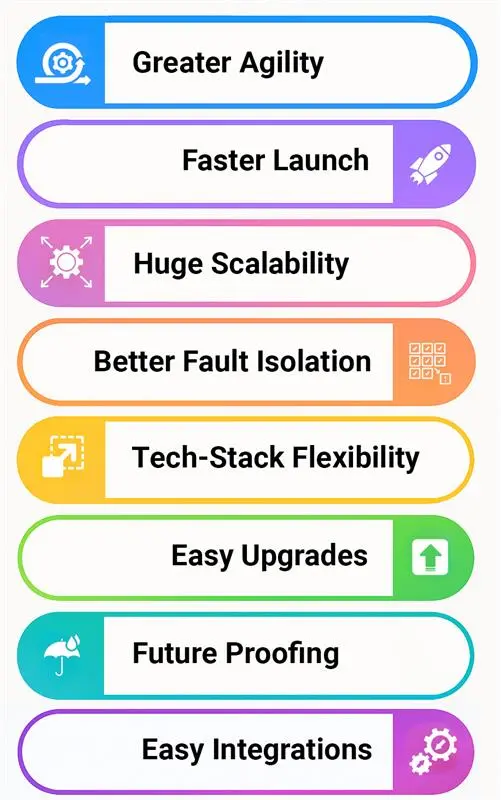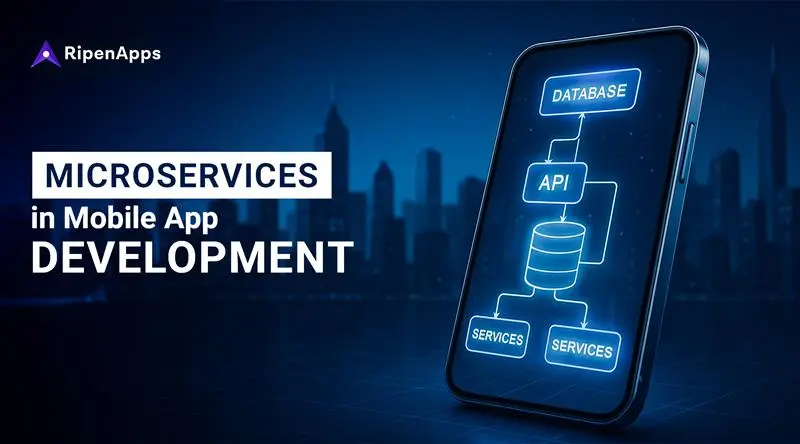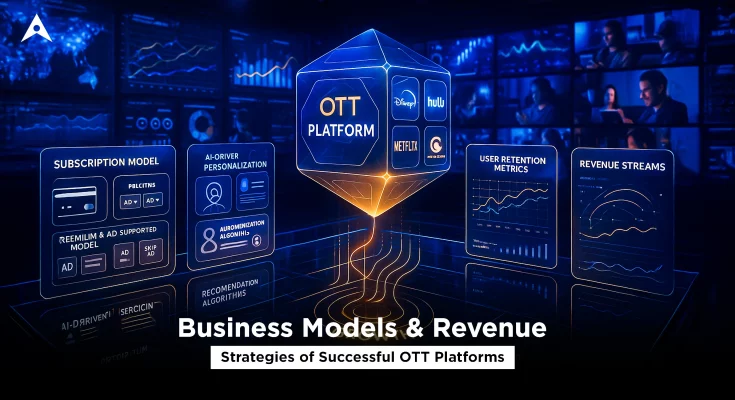Just think of building an app like assembling Lego blocks—each piece with its own purpose, but together forming a powerful, cohesive product.
That’s the philosophy behind microservices. Break down complex applications into smaller, independently deployable services that can evolve, scale, and recover without taking down the entire system.
Today’s mobile-first businesses need speed, flexibility, and resilience baked into the core of their digital architecture. And that’s precisely where microservices are changing this scenario. It’s the architectural shift that’s helping developers build apps that move at the speed of the user—and the market.
But as with any paradigm shift, microservices aren’t a silver bullet. While they promise granular control and scalability, they also introduce a new set of complexities that app owners and mobile app development teams must navigate carefully.
In this blog, we’ll explore why microservices are on the rise in mobile app development, and the benefits and real-world challenges that come with them. If you’re looking to future-proof your mobile app, this article you shouldn’t miss at all.
Table of Contents
What is Microservices in Mobile App Development?
Microservices in mobile app development primarily contrast a single entity (central app structure) to many small, independent service providers. Each of which is responsible for one specific feature or functionality.
These services are developed, deployed, and scaled independently, while they also communicate with each other through lightweight APIs as essential parts of the complete mobile system. Their flexibility becomes the winner in the fast-moving mobile space, where quick updates and high availability are a given.
The concept is based on microservice architecture, which is an architectural philosophy that decomposes complex applications into smaller, independent modules. For mobile app developers and businesses, this means quicker deployment cycles, improved fault isolation, innovation, and faster iteration without having to completely rewrite the codebase.
Why The Role of Microservices in Mobile App Development Is Rising?

The role of microservices in developing apps is increasing due to changing user needs and businesses’ new trend adoption. According to the latest market research report, the global microservices architecture market size recorded $3.7 billion in 2023, which is now estimated to attain $11.8 billion by 2032 at a CAGR of 13.75%.
This market growth in microservices has been driven by the growing need for businesses to be more agile and scalable in their software and application development. Behind this rise of microservices in mobile app development, various reasons come as benefits to businesses and app developers.
1. Greater Agility and Faster Deployment
Since the mobile app development landscape is changing due to user shifts, time to market is paramount. It is here where microservices let developers and mobile app development companies build, test, and deploy features independently. Therefore, with updates like a new checkout process or a loyalty program for your app being live, the user does not have to wait for the rest of the code base to adapt itself.
For a custom app development company, this much shorter process permits quicker experimentation and iteration cycles, making it conducive for businesses to keep responsive and remain way ahead.
2. Huge Scalability and Utilization of Resources
Every app sees its peaks. Remember an eCommerce app during Black Friday or a food delivery app during lunch hours. Microservices allow the scaling up of any services that are being pressured.
For example, say your order tracking module is overworked. You are able to upscale it without having to scale the entire application. This is amongst the most significant advantages arising from the comparison of the monolithic vs microservices architecture, where microservices protect you from resource overconsumption.
3. Enhanced Fault Isolation
In a monolithic application vs microservices environment, one of the most critical advantages of microservices is fault tolerance. In the monolithic architecture, a failure in the module payment will bring down the whole app.
With the help of microservices, should one component fails, the remaining ones will still work hand in hand. The outcome would bring in a great user experience and a reduced chance of complete system shutdowns that would indeed cost you slabs of cash and brand.
4. Tech-Stack Flexibility
Microservices allow development teams to adopt the technology stack that seems apt for an individual service. Do you need Node.js for real-time communication and Python for data analytics? No problem
Unlike monolithic systems, forcing you to use a single stack, microservices give you the flexibility of using what you find most suitable for business and technical needs. This flexibility is a strong reason why leading mobile app development company in USA has adopted microservices as its go-to architectural model.
5. Easy Upgrades and Maintenance
One of the advantages of using microservices is that they help develop apps less prone to bugs. For instance, by adding filters and optimizing code by reducing the extra, loosely coupled microservices and achieving initialization suffered by multiple digit stances. When using the microservice approach, a developer can upgrade or change one microservice, such as search, without any effect on login or cart functionality.
As time goes on, such modularity of setup allows clean codebases. This would ultimately result in greater longevity of our organization partners who have engaged a custom app development company; they thus bring money in savings for more flexible upgrade paths.
6. Stronger Alignment with Business Goals
No wonder that most microservices map to certain business functions that are analogous to payment/ billing, inventory, or customer feedback. This alignment means teams can focus on optimizing individual business processes without being entangled in unrelated code.
For product managers and CTOs, this is key. This way, you could have crystal clear KPIs, monitor performance, and innovate in parallel with much more focus. In this link, many trailblazing brands that are implementing microservices in their production, like Netflix or Amazon, have shown successful examples of microservices of how this model can build and deliver user experiences unlike any other.
Read Also : An Exclusive Netflix App Development Guide
7. Future Proofing and Easy Integrations
As a start-up, in case users end up liking your app, they might prefer adding the extra functionality. And other third-party integrations, together with AI tools and potentially even IoT connectivity. This is where microservices would obviously help streamline and diversify the matching process with minimal risk.
Implementing tiny but promising benefits like chatbot support or recommendation engines into the app with the help of chatbot development company is like plugging in new components, essentially, or fluctuating a little with the rest of the rest. It’s a great advantage in the world of continuously changing and evolving technologies
Challenges and Their Solutions in Implementing Microservices in Mobile App Development
1. Service Communication Complexity
Unlike monolithic applications that have components co-located, it create complexity in communication between distributed services for microservices. This raises an issue with data consistency, being able to manage API calls efficiently, as well as avoiding latency-borne problems due to user operations that perform interrelated touchpoints on various services simultaneously.
Solution:
To streamline the opening of communication that requires accelerated service interaction, it becomes necessary to adopt lightweight communication protocols as gRPC, or perhaps even using message brokers such as RabbitMQ. Maintaining clean API documentation files and using discovery service tools can assist in enhancing coordination and making high-performance run smoothly.
2. Data Management & Consistency
Each microservice is often allocated a separate database management system. Whereas this strategy can cater to quicker and more agile development, nevertheless, the arrangement gives rise to data consistency across the services. The problem is to ensure synchronized updates simultaneously. And the duplication of such data is a great worry, especially in real-time applications like food delivery or fintech.
Solution:
The event-driven distributed architecture and eventual consistency pattern propel one towards the right direction in maintaining good data consistency. It is helpful to maintain copies of data with data replication tools and distributed databases. Establishing a clear and simple set of rules for data ownership, as well as segregation among services, avoids clashes and builds structure and clarity.
3. UI/UX Integration across Services
When different microservices power different parts of the user interface, maintaining a consistent experience becomes difficult. Users expect seamless navigation and visual harmony, but microservices can unintentionally fragment the front-end experience.
Solution:
An appropriate UI/UX design agency can assist in amalgamating inter-service design elements and ensuring uniformity across multiple screens and functionalities. Meanwhile, using design systems and component-based front-end development frameworks like React Native ensures each service integrates cleanly without compromising user flow.
4. Deployment and DevOps Complexity
Managing continuous integration and deployment (CI/CD) pipelines for dozens of microservices is no small feat. As the number of services grows, so does the overhead for orchestration, monitoring, and rollback strategies. It becomes even more daunting in cross platform mobile app development services, where apps must work uniformly across Android and iOS.
Solution:
Containerization tools like Docker, orchestrated by Kubernetes, can help you streamline deployment processes and make service management more predictable. You can also embrace DevOps culture, automated testing, and centralized logging to implement better visibility and faster issue resolution.
5. Security Across Distributed Services
The decentralized nature of microservices increases the attack surface. Each service becomes a potential entry point for breaches, especially in apps handling sensitive data like personal identities, banking, or healthcare information.
Solution:
Try to implement end-to-end encryption in mobile app development for data in transit, API gateway security, and authentication mechanisms like OAuth 2.0. The existing API should be carefully kept safe via zero-trust software principles. Conducting regular security tests ensures the safety of data in a microservices network.
6. High overhead of managing the micro-components
The breakdown into many microservices or micro-apps very likely leads to operational overhead. Additional services will mean more maintenance, dependencies among a variety of services, and more coordination, particularly in an enterprise.
Solution:
Balance is key. Understand the trade-offs in enterprise apps vs microapps by evaluating which business functions truly benefit from decentralization. Establish governance practices, documentation standards, and inter-service contracts to minimize chaos and maintain control as the system grows.
7. Difficulties in Migration from Monolithic Systems
Migrating from a monolithic codebase to microservices is complex since it involves altering the way each module functions, manages data, and communicates. Transitioning entails procedural hazards, both technical and operational.
Solution:
To start with, carry out an analysis between monolithic vs microservices that suits your app’s primary functions and growth plans. Refactoring could start in small steps, beginning with the most modification-vulnerable services, in order to gradually migrate. Devote training resources for marketing and testing microservices in pilot projects on non-business critical modules before adopting wholesale integration transformation.
Real-World Examples of Microservices in Mobile App Development
The mobile app market is full of various successful examples of implementing microservices in their mobile apps. Let us see how some of them implemented it and got immense benefit.
1. Netflix
Netflix is a popular OTT app and the epitome of successfully deploying microservices. As Netflix matured from a monolithic stage to microservices, which now design where millions of their users hang out, they started aiming seamlessly at a vast user base worldwide for streaming.
Read Also : OTT App Development Guide
How Microservices Help:
Each and every feature in the app for Netflix, like logins, movie suggestions, streaming, billing, and searches handled by separate microservices. As such, every feature can be fired up swiftly without any interruption, while handling a voluminous number of users with minuscule latencies.
2. Spotify
With millions of users streaming music simultaneously, Spotify had to adopt microservices to ensure reliability and quick feature deployment.
Read Also : How To Create a Music Streaming App Like Spotify?
How Microservices Help:
Spotify relies on microservices for various functionalities like playlist management, search, recommendation engine, music playback, and so on. Different teams work on different microservices, thus ensuring speed to market while maintaining common user experience on both Android and iOS platforms.
3. Airbnb
Airbnb thrived on microservices to scale its services all around the globe and to smooth out experiences for users and hosts.
Read Also : Guide To Building Apps Like Airbnb
How Microservices Help:
Functions like booking, messaging, payment processing, reviews, or host services are broken down into separate service modules. This way Airbnb can dick around fast and unleash exciting new features without adversely affecting the main app functionality.
Concluding Thoughts
The rise of microservices in mobile app development marks a paradigm shift from building large, rigid structures to crafting nimble, modular ecosystems that grow, adapt, and perform under pressure. For startups chasing agility, enterprises seeking resilience, or product teams aiming for continuous delivery, microservices empower you to build apps the way users consume them—bit by bit, but beautifully connected.
So, if you’re a visionary product owner preparing for the next big digital leap, embracing microservices is the smarter move in your mobile app project. However, you will need to implement it under an expert mobile app development company which specializes in building business-oriented microservice architecture in your app. And RipenApps is one such place that can assist you in making it happen proficiently and successfully.









 India
India USA
USA Australia
Australia Canada
Canada UK
UK UAE
UAE
